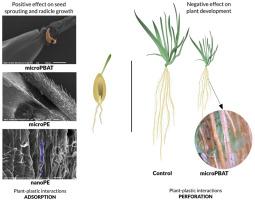Exposure of Bromus hordeaceus to fossil- and plant-based micro- and nanoplastics: Impacts and plant-plastic interactions vary depending on polymer type and growth phase
IF 8.1
2区 环境科学与生态学
Q1 ENVIRONMENTAL SCIENCES
引用次数: 0
Abstract
Plastic pollution, especially pollution by micro- and nanoplastics, is now considered a potential threat to all ecosystems, including terrestrial ecosystems such as grassland habitats. This study investigated the impacts of micro- and nano-sized plastics on Bromus hordeaceus, a common grass species in European grasslands. The micro and nanoparticles were fossil-based polyethylene (PE) or plant-based polybutylene adipate terephthalate (PBAT), and these two plastics were used at two different concentrations. Here, we report data on plant development and plastic-plant interactions from two different experiments, (1) an in vitro experiment to test seed germination and establishment and (2) a soil experiment to test plant development and plastic-plant interactions specifically investigated as a form of perforation. Results from the in vitro experiment indicate that while seed germination success was unaffected by plastic type, the presence of all plastic particle types acted as a stimulant, increasing the total length of radicles and sprouts of germinated seeds. Conversely, results from the soil experiment showed that the growth of Bromus hordeaceus was negatively affected by the presence of microPBAT in the soil during the pot assay.
Microscopic analysis confirmed that seed and plant structures interacted with all plastic particles via adsorption or perforation. This study demonstrates for the first time the ability of roots to penetrate plastics, especially microPBAT particles. Overall, our study concludes that both fossil-based and plant-based micro- and nano-plastics can influence plant growth, with effects varying based on plastic type, concentration, and plant growth phase. Further research is crucial to fully understand the intricate interactions between microplastics, soil properties, and plant development.

Bromus hordeaceus 接触化石和植物基微塑料和纳米塑料的情况:影响以及植物与塑料之间的相互作用因聚合物类型和生长阶段而异。
塑料污染,尤其是微塑料和纳米塑料污染,目前被认为是对所有生态系统的潜在威胁,包括陆地生态系统,如草原栖息地。本研究调查了微型和纳米级塑料对欧洲草原常见草种 Bromus hordeaceus 的影响。微粒和纳米粒子是化石基聚乙烯(PE)或植物基聚己二酸丁二醇酯(PBAT),这两种塑料以两种不同的浓度使用。在此,我们报告了两个不同实验中有关植物发育和塑料-植物相互作用的数据:(1) 测试种子萌发和生长的体外实验;(2) 测试植物发育和塑料-植物相互作用的土壤实验,特别是作为一种穿孔形式的调查。体外实验的结果表明,虽然种子发芽的成功率不受塑料类型的影响,但所有塑料颗粒类型的存在都会起到刺激作用,增加发芽种子的胚根和萌芽的总长度。相反,土壤实验的结果表明,在盆栽实验中,土壤中存在的微型 PBAT 会对 Bromus hordeaceus 的生长产生负面影响。显微分析证实,种子和植物结构通过吸附或穿孔与所有塑料微粒相互作用。这项研究首次证明了根系穿透塑料的能力,尤其是穿透微型 PBAT 颗粒的能力。总之,我们的研究得出结论,化石基和植物基微塑料和纳米塑料都能影响植物的生长,其影响因塑料类型、浓度和植物生长阶段而异。要全面了解微塑料、土壤性质和植物生长之间错综复杂的相互作用,进一步的研究至关重要。
本文章由计算机程序翻译,如有差异,请以英文原文为准。
求助全文
约1分钟内获得全文
求助全文
来源期刊

Chemosphere
环境科学-环境科学
CiteScore
15.80
自引率
8.00%
发文量
4975
审稿时长
3.4 months
期刊介绍:
Chemosphere, being an international multidisciplinary journal, is dedicated to publishing original communications and review articles on chemicals in the environment. The scope covers a wide range of topics, including the identification, quantification, behavior, fate, toxicology, treatment, and remediation of chemicals in the bio-, hydro-, litho-, and atmosphere, ensuring the broad dissemination of research in this field.
 求助内容:
求助内容: 应助结果提醒方式:
应助结果提醒方式:


